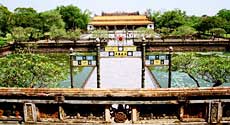The People's Committee of central Thua Thien - Hue province has given the nod to a three-year project on preservation and renovation of Ngo Mon Gate, an iconic symbol of the former royal city of Hue.
 As an important part of the Hue Imperial Citadel, which was recognised by UNESCO as a World's Heritage Site in 1993, Ngo Mon Gate is a huge U-shaped construction consisting of a brick and stone foundation and a wooden pavilion with terracotta tiles.
As an important part of the Hue Imperial Citadel, which was recognised by UNESCO as a World's Heritage Site in 1993, Ngo Mon Gate is a huge U-shaped construction consisting of a brick and stone foundation and a wooden pavilion with terracotta tiles.
The project aims to prevent water leakage from the foundation and to preserve the upper pavilion, known as Lau Ngu Phung (Pavilion of Five Phoenixes).
The first stage of the project, to begin in 2013, will cost 43.38 billion VND (2.1 million USD) and is scheduled to last three years. The second stage will be carried out after 2015. Total investment for the two stages will amount to nearly 100 billion VND (4.8 million USD).
Built in 1837 under the reign of Emperor Minh Mang (1820-1841) of the Nguyen Dynasty (1802 - 1945), the structure seriously damaged during the decades of wars against the French and Americans.
It has undergone several restorations, the latest of which was carried out between 1991 and 1992 with funding of 100,000 USD from the Japanese Government.
Located in front of the Throne Palace and facing the Flag Tower , Ngo Mon Gate serves as the main entrance to the old Imperial City of Hue. The longest and widest sides of this 5.2m-high foundation are 50m and 27m, respectively. The top can be accessed through two open stone staircases on both sides.
There are five entrances to the citadel, the main one being Ngo Mon Gate. Two side entrances, the left and right gates, were for civil and military mandarins. Inside the structure are two more gates used by soldiers, elephants and horses for the royal procession.
The Pavilion of Five Phoenixes is flanked by two belvederes of two storeys each.
Ngo Mon Gate is also the site where the king spoke to his subjects and events like the ceremony of Proclamation of Doctors' Lists in the mandarin examinations and the Calendar Offering Day were held.